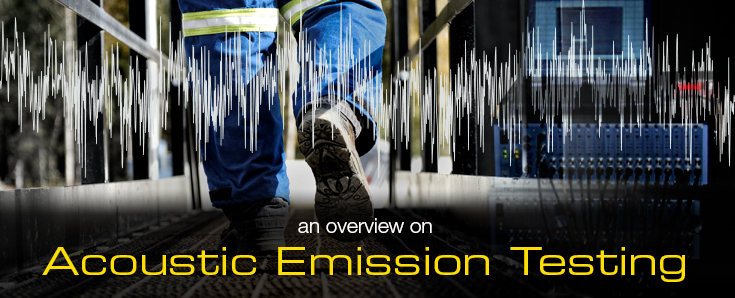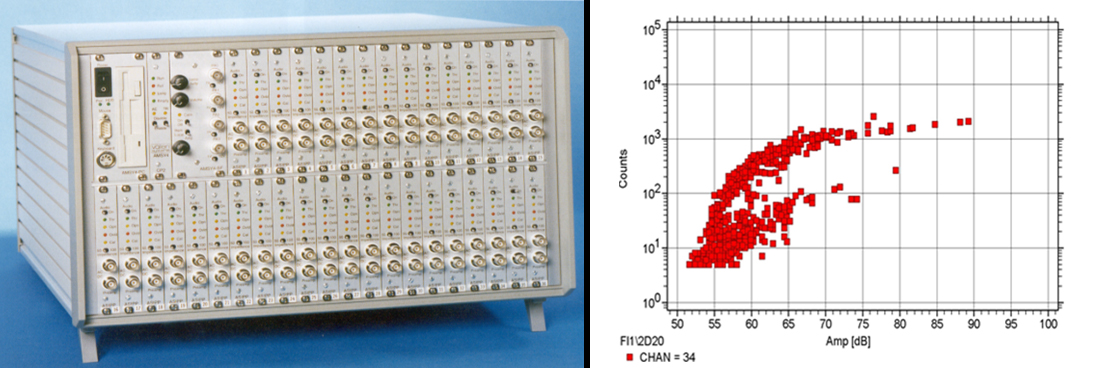An Overview on Acoustic Emission Testing

When materials are cracking, deforming or otherwise becoming damaged, they produce a kind of sound. Sometimes, these sounds are loud and obvious. Other times, they are much more subtle, and to detect them, you need to use specialized equipment. Detecting these subtler sounds through acoustic emission testing (AET) can reveal cracks and other defects that are forming which may cause significant issues, such as equipment failure, in the future if not corrected.
What are Acoustic Emissions?
The term acoustic emission (AE) refers to the creation of transient elastic waves due to rapid energy release from localized sources in a material. These acoustic waves are emitted by solid materials when they experience deformation or damage. AE is associated with a permanent alteration of the microstructure of a material. A simplified explanation is that AE is the sound produced when a material becomes damaged, although other types of waves, in addition to sound waves, may also be involved.
Various events can generate AE, including:
- The dislocation movement causes by plastic deformation or yielding
- The formation and extension of cracks in an object under stress
- Phase transformation
- Thermal stresses
- Cracking during cooldown
- Stress build-up
- Twinning, a form of crystalline distortion
- Matrix cracking
- Fiber breakage
- Debonding
AE can occur in various types of materials, including metals, plastics, polymers, concrete and wood. The characteristics of an acoustic emission depend on various factors, including the event that caused the AE and the material involved. Matrix cracking, for example, tends to produce a low amplitude emission, while crack propagation produces a higher amplitude emission.
What is Acoustic Emission Testing?
The term acoustic emission testing (AET) refers to the process of detecting and recording AE using specialized equipment. AET is a type of nondestructive test (NDT) that has various uses, including ensuring the structural integrity of vessels, monitoring weld quality and more. The process involves using sensors to detect AE and then converting the waves into electrical signals so that they can be recorded. You can then analyze the results to assess a material’s condition and locate any defects. The recorded information can provide potentially valuable information about the origin and significance of a defect in a structure.
There are several slightly different methods used for acoustic emission testing. Some of the main methods include:
- Global screening: One method is used to screen all components and involves increasing stress levels to slightly above normal using thermal or pressure gradients to reveal stress risers and cracks. For example, you might increase the pressure in a reactor to 110% of the typical maximum operating pressure. Raising the pressure should reveal active defects that are not apparent under normal operating conditions but will likely continue to worsen over time.
- Monitoring during Normal Operating Conditions: Another method involves monitoring known flaws or detecting unknown flaws that can’t easily be discovered by increasing stress levels. With this method, the AE signals result from actual damage progression or crack propagation. For example, you might monitor coke drums over time for thermally induced fatigue cracks. In this method, rather than artificially increasing the load for the purpose of testing, you use AET to monitor a vessel for significant damage progression.
- Proof tests: The goal of a proof test is to show that a given structure can handle loads up to a certain amount. In the test, you increase the load to the required amount. If successful, the test will not record any significant emissions.
- Failure tests: A failure test aims to determine the load at which a structure begins to fail. It involves gradually increasing the load until the system begins to record emissions that indicate failure is beginning to occur.
- Fatigue tests: Fatigue tests involve applying a cyclic load to a structure to estimate its working lifetime.

Setting Up the Equipment
For testing a small component, you may only use one acoustic emission sensor. Typically, however, multiple sensors are used and spread across the surface of the object. This is, in part, because different sensors may pick up different signal characteristics for the same emission event, especially in complex structures. When setting up sensors, it’s typically ideal that each area of interest is within the acoustic range of at least three sensors. Often, a pattern of interlocking triangles or interlocking rectangles is used to set up sensors.
It’s also important to use a fluid couplant to help the sensor obtain a stronger signal, which it does by increasing the surface area that is transmitting the force. Various types of fluid couplants can be used, including resins, greases and sealants. Different types of couplants may work best in different applications. Couplants can also help bond the sensor to the surface, and tape, magnetic hold-downs, springs or other items are used to further secure the sensors.
The sensors are connected to a low-noise preamplifier and a main amplifier, as well as additional electronic equipment used to filter and isolate the sound. These devices help make the reading clearer and easier to analyze accurately. Shielding is also important for reducing electrical noise. The sensors and other equipment are connected using coaxial cables to a computer that records the readings.
Running the Test
After setting up the equipment, the test is begun by applying the required load. For example, the test may require increasing the pressure in a vessel to slightly above the normal operating pressure. The system may also continue to operate as usual if the test aims to monitor performance under normal operating conditions.
Once the test begins, the AET system will record any AE above a pre-determined threshold, along with the exact time it occurred. The system will record data related to emission count, signal length, peak amplitude, emission strength and other chosen parameters. The distance between the emission source and the sensor affects the recorded emission strength, so the strength recorded by multiple sensors is often averaged to help estimate the strength of each emission.
Various techniques can be used in acoustic emission testing. The ideal equipment setup and testing process depend on the type of structure being tested, the material being tested, the type of test being conducted and other factors.
Analyzing the Results
Once the test is complete, the results are analyzed. Alternatively, for some types of tests, you can conduct analysis while the test is taking place. Analysis involves looking for the occurrence of AE, measuring the rate of each emission and determining the location of any defects. With modern computer systems, the results of the test show up as a graph, which helps in interpreting the results. By measuring the arrival time of an AE signal to each sensor, you can determine the defect’s location using triangulation. After locating the flaw, you can perform additional inspection or begin taking steps toward correcting the flaw.

What Are the Applications of Acoustic Emission Testing?
AET is very versatile and has many applications across a variety of industries. It’s also used as a research tool. Some of the applications of AET include:
- Detection of active sources, including yielding, crack propagation, fatigue, creep, fiber delamination, fiber fracture, and corrosion.
- Structural integrity evaluation
- In-field inspection
- Weld quality monitoring
- Production quality control
- Leak detection
- Monitoring chemical reactions and phase changes
- Laboratory and research and development (R&D) studies
Who Uses Acoustic Emission Testing?
A wide variety of industries can use AET, including:
- Aerospace: The aerospace sector can use AET to assess aging aircraft, motors and fuel storage tanks.
- Alternative energy sources: AET is useful for testing the structural integrity of alternative energy infrastructure such as wind turbines.
- Automotive: Automotive manufacturers may use AET to assess vehicle components, as well as factory equipment.
- Chemical and refinery: Companies in the chemical and refinery sector can use AET to test for defects in plant equipment and vessels.
- Infrastructure: AET is valuable for testing the structural integrity of bridges, tunnels, dams and other types of infrastructure.
- Manufacturing: Manufacturers can use AET to test a wide range of manufacturing equipment types, as well as ensure product quality of certain types of goods.
- Materials research and development: Those working in materials research and development can use AET to test the integrity of new and existing materials in various applications.
- Nuclear power: AET can be used to inspect nuclear components, such as lift beams, valves and steam lines.
- Offshore drilling: AET can provide early detection of faults in offshore drilling platforms and pipelines.
- Oil and gas: Oil and gas companies can use AET to test pipelines, vessels and processing equipment.
- Power distribution: AET can be used for partial discharge detection in power transformers.
- Pressure vessels and piping: Manufacturers of pressure vessels may use AET to ensure product quality. Users of this equipment may also use AET to test the condition of their equipment.
- Process technology: Process technology professionals in the fields of wastewater treatment, chemical processing, power generation and more can use AET to test the integrity of system components.
- Pulp and paper: AET is used in the pulp and paper industry for testing the integrity of vessels, tanks, piping, tubing and other equipment used in manufacturing operations.
- Transportation: AET is useful for testing various types of transportation equipment, including railroad tank cars, marine vessels, motors, tube trailers and more.
What Are the Advantages of AET?
AET can be used for the early detection of flaws as well as real-time monitoring. It is a high-sensitivity test method and offers advantages including:
- Early damage detection: Because AET detects the growth of cracks and flaws and is a highly sensitive test method, it can detect relatively small (micro) defects early on. This early detection enables you to repair flaws before they cause significant issues.
- Global, simultaneous inspection: With AET, you can inspect an entire unit or system simultaneously, including pressure vessels, reactors, piping and other components. This results in a more efficient, cost-effective testing process and enables you to test even large systems relatively quickly.
- No need for shutdown: AET can often be performed on a unit while it is in operation, avoiding the need for a shutdown. You can also perform AET during an in-service over-pressurization or scheduled cool-down. Avoiding a shutdown can reduce costs significantly and help keep productivity levels consistent.
- Identification of only active defects: AET only identifies active defects — those that are growing. This feature means that only flaws that are likely to cause significant issues in the future are identified, while stable cracks and old fabrications defects are not. This enables you to focus on the most significant issues, saving your company time and money.
- Immediate indication of risk: With AET, you get an immediate indication of the strength of a given component and the risk of failure, enabling you to respond quickly if needed.
- Minimal disruption to insulation: Typically, only small holes in insulation are required to mount sensors. You may also be able to place permanent sensors underneath insulation.
- Compliance assistance: Several standards recognize AET, and it can help ensure compliance with local, state and federal regulations.
- Reduced costs: Using AET can reduce costs significantly by avoiding downtime, reducing test time, requiring minimal disruption to insulation and identifying only the defects that may cause significant issues in the future if not corrected.
What Are the Limitations of AET?
Like any test method, AET also has some limitations, which means it may not be the right choice for every application. In some cases, organizations may benefit from supplementing AET with other test methods. Some of the disadvantages of AET include that it:
- Can only provide qualitative results: AET can only provide qualitative results, not quantitative results. It can detect that a flaw exists, but determining the size and depth of a crack, for example, requires other test methods, such as ultrasonic testing.
- Can only find active flaws: The fact that AET only identifies active flaws can be an advantage, but, in some cases, you may also want to identify stagnant defects. AET would not work for this purpose. It’s also possible that AET may not detect relatively minor active flaws if the loading is not enough to result in an acoustic event.
- Loud environments present challenges: It can be more challenging to get accurate results from AET when it is performed in loud service environments. To filter out excess noise, signal discrimination and noise reduction techniques and technologies are required.
- Requires specific skills and knowledge: Performing AET requires an experienced, knowledgeable and skilled operator. It also involves the use of relatively complex and expensive hardware and software.

AET Standards
Various organizations, including standards organizations, industry organizations and government agencies, publish standards or oversee regulations related to acoustic emission testing. These documents offer guidance for conducting AET. Conducting AET according to the requirements in these documents can also help organizations earn and maintain compliance with the relevant standards and regulations. Some of the organizations that publish standards and other documents related to AET include:
- The International Organization for Standardization (ISO): ISO has published various standards related to AET, which include standards for calibrating AE sensors, classifying active cracks in concrete structures and using AET for leak detection.
- The American Society of Mechanical Engineers (ASME): ASME has released numerous publications that discuss AET and covers requirements for AET in ASME Sec V Articles 11, 12 and 13.
- The American Society for Testing and Materials (ASTM): ASTM has also published various standards related to AET, including standards for Acoustic Emission Monitoring of Structures During Controlled Stimulation, Continuous Monitoring of Acoustic Emission from Metal Pressure Boundaries, testing aerial personnel devices and more.
- The European Committee for Standardization (CEN): CEN standards related to AET include standards for testing liquified petroleum gas equipment, calibrating AE transducers and testing metallic industrial piping.
- The Japanese Standards Association (JSA): JIS Z 2342:2003 from JAS describes methods for acoustic emission testing of pressure vessels.
- The American Society for Nondestructive Testing (ASNT): ASNT SNT-TC1A from ASNT describes requirements for qualification and certification of personnel in nondestructive testing, including AET.
- The Committee on Acoustic Emission from Reinforced Plastics (CARP): CARP has published various documents on using AET to test piping, tanks, pressure vessels and other objects made of reinforced plastics.
- The Institute of Electrical and Electronics Engineers (IEEE): IEEE has published PC57.127/D10.0, which is a guide for detecting and locating AE due to partial discharges in oil-immersed power reactors and transformers.
- The Electric Power Research Institute (EPRI): EPRI has published various guidelines, research papers and other technical documents related to AET, including guidelines for evaluating seam-welded high-energy piping.
- The American Petroleum Institute (API): API discusses AET in various documents, including ANSI/API 510, its pressure vessel inspection code.
- The Compressed Gas Association (CGA): CGA’s C-18 describes methods for requalifying seamless steel tubes used for compressed gas with AET.
Some of the U.S. government agencies that regulate, publish standards about or offer certifications related to AET include:
- The U.S. Coast Guard
- The U.S. Department of Transportation (DOT)
- The U.S. Department of Energy (DOE)
- The U.S. Nuclear Regulatory Commission (NRC)
- The National Aeronautics and Space Administration (NASA)
Work with Stress Engineering Services, an Expert in Acoustic Emission Testing
With internationally recognized expertise on-staff, we offer more than simply the ability to conduct Acoustic Emissions Testing. We can conduct AET according to your needs and fully analyze the test results. Our AET testing service can help you ensure your equipment performs reliably, reduce your costs and maintain compliance with standards and regulations. To learn more, contact us today.

Get to know our AET experts!
At Stress Engineering Services we have been providing quality design, testing, and analytical services for a variety of pressure vessels, piping, heat exchangers and other process equipment since 1972. This experience includes full scale testing, laboratory and field data acquisition, failure analysis, and teaching seminars in pressure vessel and piping design. We offer in-depth experience with FEA using ANSYS, PATRAN, ABAQUS, etc. and numerous Code and other classical calculations that have satisfied a multitude of clients with varied applications.




Leave a Comment
You must Register or Login to post a comment.